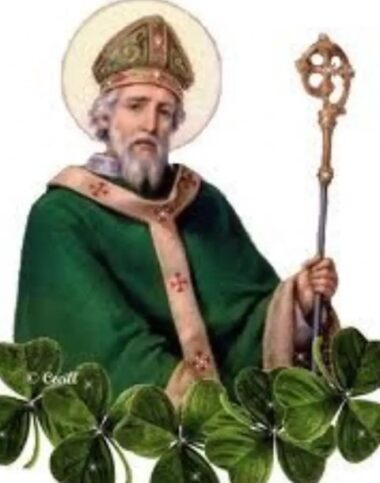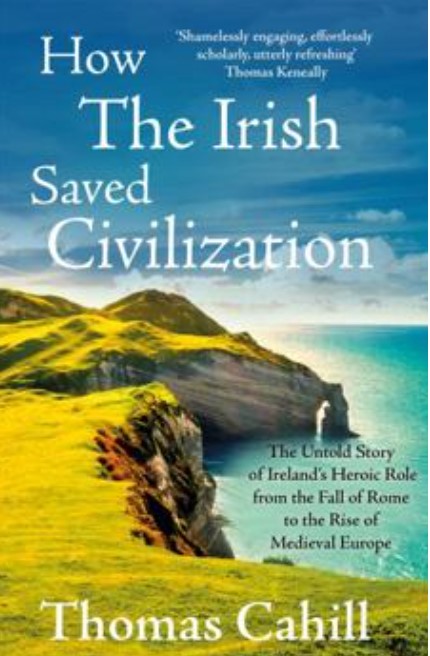What Color is the Day?

This was one of our Big Days, back when they still had relative sizes. There would be a general destination specified and an approximate set time to arrive Kitty O’Shea’s (11:00 Opening) or Ireland’s Four Courts (10:30) sometime this morning for a pint or four. We do not have that sort of stamina in the Writer’s Section at Socotra House, and tried to unscramble the mass of un-congealed mis-dis & mal information that needs to be manipulated into some consistency with larger messaging campaigns by tomorrow morning.
We thought some activity restricted to The Patio might be a better approach. There was a suggestion of pouring green-tinged fluids on the black asphalt, but realized that could get the Legal Section in a taller uproar than usual on a Sunday and dropped the idea. But we did decide to pay a little tribute to the Chairman’s family, since the O’Socotras of yore were a hearty bunch.

We read some of Thomas Cahill’s marvelous book “How the Irish Saved Civilization” several years ago. He cited the seminal contribution to Western Civilization of the toiling Irish scribes who copied the literature of Greece and Imperial Rome and preserved the glory that was to be reflected in the glory to come.
The monks scoured barbarian Europe for manuscripts in the same manner the Writer’s Section searched for suds this morning. This is a dual-hazard day of tribute to Saints, since the Virginia ABC outlets are closed, and reminding ourselves today to shop yesterday has not been an effective strategy. So, we leaned into our efforts with Cahill.
He tells the story of Europe’s evolution from classical Rome to the medieval era. Without Ireland, Cahill argues, the transition could not have taken place. Not only did Irish monks and scribes maintain the very record of Western civilization, they brought their uniquely Irish world-view to the task.
That is where things get confused enough to merit inclusion in our modern celebration of Patrick’s Day. But what is most significant to us is not the happy circumstance by which the Irish Monks saved the knowledge of classical times. Rather, it is Cahill’s succinct account of how Rome’s Empire of eleven centuries fell with barely a whimper to the Goths and Gauls and Vandals.
During the centuries all of Ireland was ruled by the British, the rulers preferred the hue of “blue.” They even assigned a particular shade resembling that of the clear sky to Saint Patrick, but the azure color fell into disfavor among the Irish. Henry VIII declared himself king of Ireland in 1541, and he gave Ireland a coat of arms all its own: the image of a golden harp on a background of blue named for the Saint.
In the late 1700s, the association between blue and St. Patrick continued to swirl. George III did not spend all his free time persecuting rebels in North America. He also created a new order of chivalry, the Order of St. Patrick. The official color was sky blue.
The ever-rebellious Irish wrestled against the British. They had chosen a different color. They preferred green, the color of the shamrock with which Patrick used to explain Christian beliefs to the Irish he met after he was kidnapped by them. The significance of the three-leafed shamrock was the teaching point Patrick used to describe the three forms of divinity- Father, Son and Holy Spirit- to convert early Irish people to Christianity.
In the Great Irish Rebellion of 1641, Irish military leader Owen Roe O’Neill’s sailing vessels flew a flag that depicted an Irish harp. A harp on a field of green instead of blue, An Englishman named Thomas Dineley traveled through Ireland in 1681 and “reported people wearing crosses of green ribbon in their hats on Saint Patrick’s Day.”
The moment of a rebellion formed in color arrived in the late 1700s. An underground group sought to emulate the successful American Revolution against the Crown. To avoid being spotted by the English, an Irish nationalist might wear a subtle hint of green, such as a green feather in his cap. The poorly-armed rebels were crushed by the British as usual, but the idea of wearing shamrocks attached to hats and the color green as nationalist symbols persisted through the years.
A street ballad titled “The Wearin’ o’ The Green” was written anonymously around 1798. It conveyed a distinctly rebellious meaning in a time of (almost) uncontrolled ex-migration. The commonality of issues across our centuries is striking, you know? Here this week it is migration- albeit from the South- and taxes.
That issue has been around since Rome left, retaining status as a common irritant across the last thousand years of our common history. The President’s Budget for Fiscal 2025 just got rolled out by the people on the other side of our common River. It contains the varieties of mathematic lunacy we support regularly on your behalf.
That is something to raise a glass to on this day, don’t you think? We have some notes about other ones. that Saint Patrick’s Day was not just blue, instead of Green, but it was the irish Tourist Board that suggested this day might be a good one for a pint or five.
We decided to agree, and Splash brought a shamrock to the morning meeting. “Ireland’s Own” doesn’t open for a couple hours, you know?
Copyright 2010 Vic Socotra
www.vicsocotra.com
